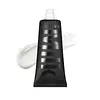What's inside
What's inside
 Key Ingredients
Key Ingredients

 Benefits
Benefits

 Concerns
Concerns

 Ingredients Side-by-side
Ingredients Side-by-side

Water
Skin ConditioningSilica
AbrasivePropanediol
SolventNylon-11
Pentylene Glycol
Skin ConditioningNiacinamide
SmoothingPolyglyceryl-10 Diisostearate
EmulsifyingDicaprylyl Ether
EmollientCorn Starch Modified
AbsorbentBakuchiol
AntimicrobialParfum
MaskingHamamelis Virginiana Water
AstringentButyrospermum Parkii Butter Unsaponifiables
Skin ConditioningLens Esculenta Seed Extract
Skin ProtectingShorea Robusta Seed Butter
EmollientCoffea Arabica Seed Oil
MaskingGlycine Soja Oil
EmollientTocopherol
AntioxidantMoonstone Powder
Skin ConditioningGlyceryl Undecylenate
EmollientEthyl Stearate
EmollientEthyl Palmitate
EmollientEthyl Oleate
EmollientEthyl Linoleate
EmollientAcrylates/Beheneth-25 Methacrylate Copolymer
Ethyl Macadamiate
Skin ConditioningMalic Acid
BufferingSodium Carbomer
Emulsion StabilisingSaccharide Isomerate
HumectantSodium Hyaluronate
HumectantSodium Hydroxide
BufferingTrisodium Ethylenediamine Disuccinate
Ethylhexylglycerin
Skin ConditioningGlyceryl Caprylate
EmollientPhenoxyethanol
PreservativeLinalool
PerfumingWater, Silica, Propanediol, Nylon-11, Pentylene Glycol, Niacinamide, Polyglyceryl-10 Diisostearate, Dicaprylyl Ether, Corn Starch Modified, Bakuchiol, Parfum, Hamamelis Virginiana Water, Butyrospermum Parkii Butter Unsaponifiables, Lens Esculenta Seed Extract, Shorea Robusta Seed Butter, Coffea Arabica Seed Oil, Glycine Soja Oil, Tocopherol, Moonstone Powder, Glyceryl Undecylenate, Ethyl Stearate, Ethyl Palmitate, Ethyl Oleate, Ethyl Linoleate, Acrylates/Beheneth-25 Methacrylate Copolymer, Ethyl Macadamiate, Malic Acid, Sodium Carbomer, Saccharide Isomerate, Sodium Hyaluronate, Sodium Hydroxide, Trisodium Ethylenediamine Disuccinate, Ethylhexylglycerin, Glyceryl Caprylate, Phenoxyethanol, Linalool
Water
Skin ConditioningDimethicone
EmollientSilica
AbrasiveAlcohol Denat.
AntimicrobialDimethicone/Vinyl Dimethicone Crosspolymer
Skin ConditioningGlycerin
HumectantButylene Glycol
HumectantBis-PEG-18 Methyl Ether Dimethyl Silane
EmollientPEG/PPG/Polybutylene Glycol-8/5/3 Glycerin
HumectantIsopropyl Lauroyl Sarcosinate
Skin ConditioningHydroxyethylpiperazine Ethane Sulfonic Acid
BufferingPolyglyceryl-3 Disiloxane Dimethicone
Skin ConditioningSilica Silylate
EmollientLactic Acid
BufferingAmmonium Polyacryloyldimethyl Taurate
Emulsion StabilisingPhenoxyethanol
PreservativeCapryloyl Salicylic Acid
ExfoliatingPPG-6-Decyltetradeceth-30
EmulsifyingSodium Hydroxide
BufferingSalicylic Acid
MaskingPEG-20 Methyl Glucose Sesquistearate
EmulsifyingSodium Polyacrylate
AbsorbentXanthan Gum
EmulsifyingTrisodium Ethylenediamine Disuccinate
Sodium Citrate
BufferingAdenosine
Skin ConditioningTocopherol
AntioxidantLinalool
PerfumingCI 14700
Cosmetic ColorantCeramide AP
Skin ConditioningWater, Dimethicone, Silica, Alcohol Denat., Dimethicone/Vinyl Dimethicone Crosspolymer, Glycerin, Butylene Glycol, Bis-PEG-18 Methyl Ether Dimethyl Silane, PEG/PPG/Polybutylene Glycol-8/5/3 Glycerin, Isopropyl Lauroyl Sarcosinate, Hydroxyethylpiperazine Ethane Sulfonic Acid, Polyglyceryl-3 Disiloxane Dimethicone, Silica Silylate, Lactic Acid, Ammonium Polyacryloyldimethyl Taurate, Phenoxyethanol, Capryloyl Salicylic Acid, PPG-6-Decyltetradeceth-30, Sodium Hydroxide, Salicylic Acid, PEG-20 Methyl Glucose Sesquistearate, Sodium Polyacrylate, Xanthan Gum, Trisodium Ethylenediamine Disuccinate, Sodium Citrate, Adenosine, Tocopherol, Linalool, CI 14700, Ceramide AP
Ingredients Explained
These ingredients are found in both products.
Ingredients higher up in an ingredient list are typically present in a larger amount.
Linalool is a fragrance and helps add scent to products. It's derived from common plants such as cinnamon, mint, citrus, and lavender.
Like Limonene, this ingredient oxidizes when exposed to air. Oxidized linalool can cause allergies and skin sensitivity.
This ingredient has a scent that is floral, spicy tropical, and citrus-like.
Learn more about LinaloolPhenoxyethanol is a preservative that has germicide, antimicrobial, and aromatic properties. Studies show that phenoxyethanol can prevent microbial growth. By itself, it has a scent that is similar to that of a rose.
It's often used in formulations along with Caprylyl Glycol to preserve the shelf life of products.
Silica, also known as silicon dioxide, is a naturally occurring mineral. It is used as a fine, spherical, and porous powder in cosmetics.
Though it has exfoliant properties, the function of silica varies depending on the product.
The unique structure of silica enhances the spreadability and adds smoothness, making it a great texture enhancer.
It is also used as an active carrier, emulsifier, and mattifier due to its ability to absorb excess oil.
In some products, tiny microneedles called spicules are made from silica or hydrolyzed sponge. When you rub them in, they lightly polish away dead skin layers and enhance the penetration of active ingredients.
Learn more about SilicaSodium Hydroxide is also known as lye or caustic soda. It is used to adjust the pH of products; many ingredients require a specific pH to be effective.
In small amounts, sodium hydroxide is considered safe to use. However, large amounts may cause chemical burns due to its high alkaline.
Your skin has a natural pH and acid mantle. This acid mantle helps prevent harmful bacteria from breaking through. The acid mantle also helps keep your skin hydrated.
"Alkaline" refers to a high pH level. A low pH level would be considered acidic.
Learn more about Sodium HydroxideTocopherol (also known as Vitamin E) is a common antioxidant used to help protect the skin from free-radicals and strengthen the skin barrier. It's also fat soluble - this means our skin is great at absorbing it.
Vitamin E also helps keep your natural skin lipids healthy. Your lipid skin barrier naturally consists of lipids, ceramides, and fatty acids. Vitamin E offers extra protection for your skin’s lipid barrier, keeping your skin healthy and nourished.
Another benefit is a bit of UV protection. Vitamin E helps reduce the damage caused by UVB rays. (It should not replace your sunscreen). Combining it with Vitamin C can decrease sunburned cells and hyperpigmentation after UV exposure.
You might have noticed Vitamin E + C often paired together. This is because it is great at stabilizing Vitamin C. Using the two together helps increase the effectiveness of both ingredients.
There are often claims that Vitamin E can reduce/prevent scarring, but these claims haven't been confirmed by scientific research.
Learn more about TocopherolTrisodium Ethylenediamine Disuccinate is used to help stabilize a product.
It is a chelating agent, meaning it helps prevent metal ions from binding to other ingredients. This prevents unwanted reactions in products. Metal ions can come into a product via the water ingredient. They are found in trace amounts and are not known to be harmful.
Water. It's the most common cosmetic ingredient of all. You'll usually see it at the top of ingredient lists, meaning that it makes up the largest part of the product.
So why is it so popular? Water most often acts as a solvent - this means that it helps dissolve other ingredients into the formulation.
You'll also recognize water as that liquid we all need to stay alive. If you see this, drink a glass of water. Stay hydrated!
Learn more about Water